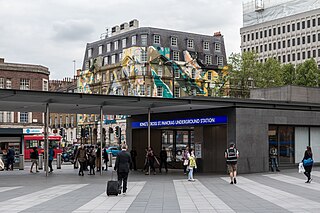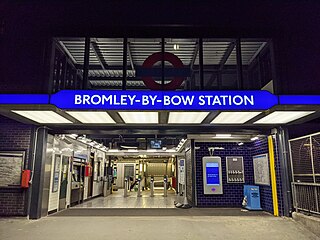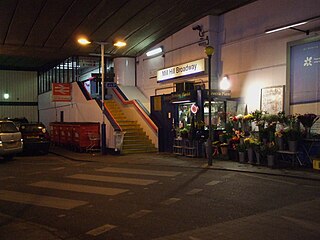
Thameslink is a mainline route on the British railway network, running from Bedford, Luton, St Albans City, Peterborough, Welwyn Garden City, London Blackfriars and Cambridge via central London to Sutton, Orpington, Sevenoaks, Rainham, Horsham, Three Bridges, Brighton and East Grinstead. The network opened as a through service in 1988, with severe overcrowding by 1998, carrying more than 28,000 passengers in the morning peak. All the services are currently operated by Govia Thameslink Railway. Parts of the network, from Bedford to Three Bridges, run 24 hours a day, except on early Sunday mornings and during maintenance periods.

King's Cross St Pancras is a London Underground station on Euston Road in the Borough of Camden, Central London. It serves King's Cross and St Pancras main line stations in fare zone 1, and is an interchange between six Underground lines. The station was one of the first to open on the network. As of 2022, it is the most used station on the network for passenger entrances and exits combined.

Camden Town is a London Underground station in Camden Town. It is a major junction for the Northern line, as it is where the Edgware and High Barnet branches merge from the north, and is also where they split to the south into the Bank and Charing Cross branches for the journey through Central London. It is particularly busy with visitors to the Camden markets at weekends, and, until 2019, was exit-only on Sundays to prevent overcrowding.

St Pancras railway station, officially known since 2007 as London St Pancras International, is a major central London railway terminus on Euston Road in the London Borough of Camden. It is the terminus for Eurostar services from Belgium, France and the Netherlands to London. It provides East Midlands Railway services to Leicester, Corby, Derby, Sheffield and Nottingham on the Midland Main Line, Southeastern high-speed trains to Kent via Ebbsfleet International and Ashford International, and Thameslink cross-London services to Bedford, Cambridge, Peterborough, Brighton, Horsham and Gatwick Airport. It stands between the British Library, the Regent's Canal and London King's Cross railway station, with which it shares a London Underground station, King's Cross St Pancras.

King's Cross Thameslink station is a closed railway station in central London, England. It is located on Pentonville Road, around 250 metres (0.2 mi) east of King's Cross mainline station. At the time of closure, in 2007, it was served by Thameslink trains and managed by First Capital Connect. Services have been transferred to a new station underneath St Pancras.

Moorgate is a central London railway terminus and connected London Underground station on Moorgate in the City of London. Main line railway services for Hertford, Welwyn Garden City and Stevenage are operated by Great Northern, while the Underground station is served by the Circle, Hammersmith & City, Metropolitan and Northern lines.

Euston is a London Underground station. It directly connects with its National Rail railway station above it. The station is in Travelcard Zone 1.

Old Street is an interchange station at the junction of Old Street and City Road in Central London for London Underground and National Rail services.

Blackfriars, also known as London Blackfriars, is a central London railway station and connected London Underground station in the City of London. It provides Thameslink services: local, and regional and limited Southeastern commuter services to South East London and Kent. Its platforms span the River Thames, the only one in London to do so, along the length of Blackfriars Railway Bridge, a short distance downstream from Blackfriars Bridge. There are two station entrances either side of the Thames, along with a connection to the London Underground District and Circle lines.

Farringdon is an interchange station located in Clerkenwell, London, England, in the London Borough of Islington, just outside the boundary of the City of London for London Underground, Elizabeth line and National Rail services.

Barbican is a London Underground station situated near the Barbican Estate, on the edge of the ward of Farringdon Within, in the City of London in Central London. It has been known by various names since its opening in 1865, mostly in reference to the neighbouring ward of Aldersgate.

Wimbledon is an interchange station in the centre of Wimbledon in London for London Underground, London Trams and National Rail services, and is the only station in London that provides an interchange between the London Underground and Tramlink.

Bromley-by-Bow is a London Underground station located on the Blackwall Tunnel Northern Approach Road in the Bromley-by-Bow area of London, United Kingdom. The station is below the Blackwall Tunnel Northern Approach Road and lies between Bow Road and West Ham stations on the District and Hammersmith & City lines, and is in both Travelcard Zones 2 and 3.

Cricklewood railway station is on the Midland Main Line in England, serving the town of Cricklewood in the London Borough of Barnet, north London. It is 5 miles 9 chains (8.2 km) down the line from St Pancras and is situated between West Hampstead Thameslink to the south and Brent Cross West to the north. Its three-letter station code is CRI.

Hendon railway station is on the Midland Main Line in England, in West Hendon in the London Borough of Barnet, north London. It is 6 miles 79 chains (11.2 km) down the line from St Pancras and is situated between Brent Cross West to the south and Mill Hill Broadway to the north. Its three-letter station code is HEN.

Mill Hill Broadway railway station is on the Midland Main Line in England, serving the suburb of Mill Hill in the London Borough of Barnet, north London. It is 9 miles 28 chains (15.0 km) down the line from St Pancras and is situated between Hendon to the south and Elstree & Borehamwood to the north. Its three-letter station code is MIL.

Elstree & Borehamwood railway station is a railway station in the town of Borehamwood, Hertfordshire, England. It primarily serves Borehamwood as well as the nearby village of Elstree, 1.3 miles (2.1 km) to the south-west. The station is situated on the Midland Main Line, 12 miles 35 chains (20.0 km) down the line from London St Pancras and is situated between Mill Hill Broadway to the south and Radlett to the north. Its three-letter station code is ELS.

Luton Airport Parkway railway station is on the Midland Main Line in England, serving south Luton and Luton Airport in Bedfordshire. The station is situated in Luton's Park Town district, being 29.27 miles (47.11 km) from London St Pancras between Harpenden to the south and Luton to the north. Its three-letter station code is LTN, also the IATA code for the airport.

West Hampstead Thameslink is a National Rail station on the Midland Main Line and is served by Thameslink trains as part of the Thameslink route between Kentish Town and Cricklewood. The station is in Travelcard Zone 2.

Elephant & Castle railway station is a National Rail station in Newington, south London. Along with the London Underground station of the same name, it is located in the London Borough of Southwark and is in both Travelcard Zone 1 and 2. The station is managed by Thameslink, with services operated by both Thameslink and Southeastern. There is out-of-station interchange with the nearby Elephant & Castle tube station.


























